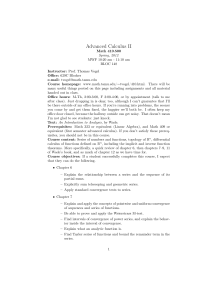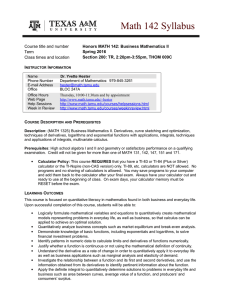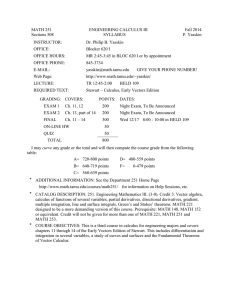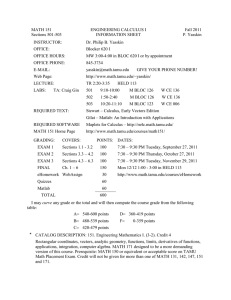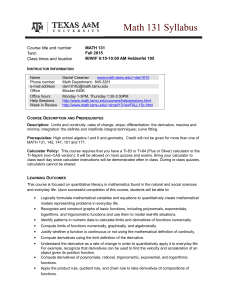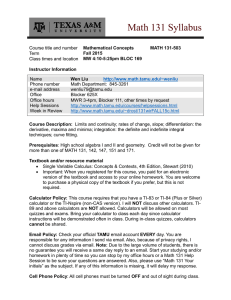Spring 2016 Math 142: Business Math II Syllabus I
advertisement
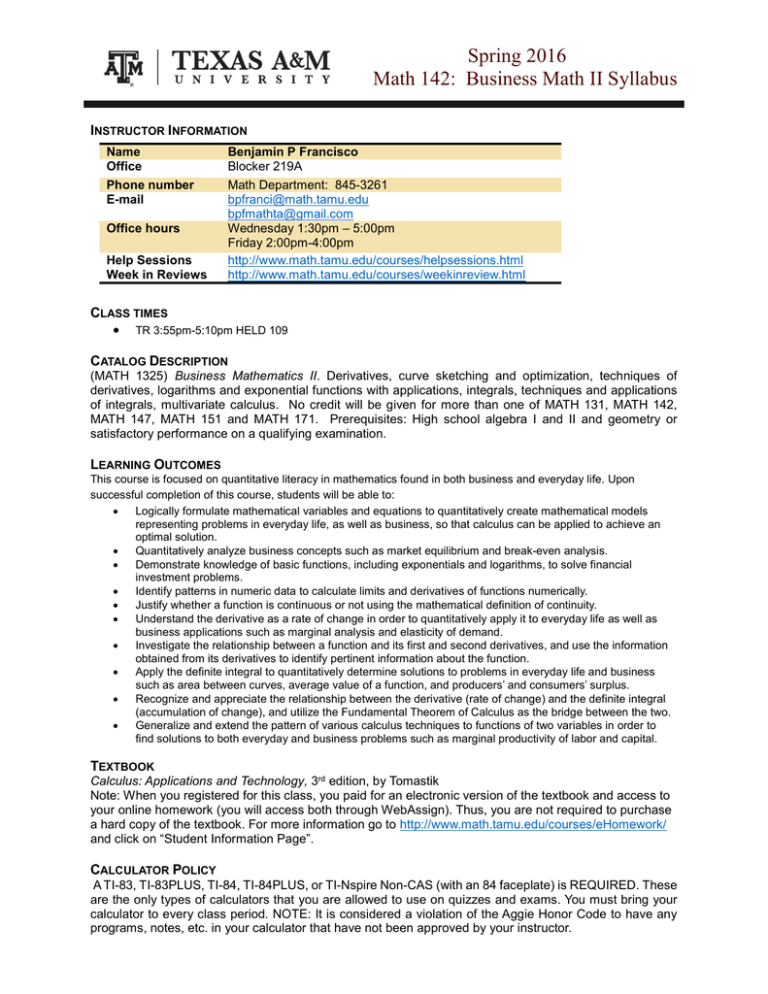
Spring 2016 Math 142: Business Math II Syllabus INSTRUCTOR INFORMATION Name Office Phone number E-mail Office hours Help Sessions Week in Reviews Benjamin P Francisco Blocker 219A Math Department: 845-3261 bpfranci@math.tamu.edu bpfmathta@gmail.com Wednesday 1:30pm – 5:00pm Friday 2:00pm-4:00pm http://www.math.tamu.edu/courses/helpsessions.html http://www.math.tamu.edu/courses/weekinreview.html CLASS TIMES TR 3:55pm-5:10pm HELD 109 CATALOG DESCRIPTION (MATH 1325) Business Mathematics II. Derivatives, curve sketching and optimization, techniques of derivatives, logarithms and exponential functions with applications, integrals, techniques and applications of integrals, multivariate calculus. No credit will be given for more than one of MATH 131, MATH 142, MATH 147, MATH 151 and MATH 171. Prerequisites: High school algebra I and II and geometry or satisfactory performance on a qualifying examination. LEARNING OUTCOMES This course is focused on quantitative literacy in mathematics found in both business and everyday life. Upon successful completion of this course, students will be able to: Logically formulate mathematical variables and equations to quantitatively create mathematical models representing problems in everyday life, as well as business, so that calculus can be applied to achieve an optimal solution. Quantitatively analyze business concepts such as market equilibrium and break-even analysis. Demonstrate knowledge of basic functions, including exponentials and logarithms, to solve financial investment problems. Identify patterns in numeric data to calculate limits and derivatives of functions numerically. Justify whether a function is continuous or not using the mathematical definition of continuity. Understand the derivative as a rate of change in order to quantitatively apply it to everyday life as well as business applications such as marginal analysis and elasticity of demand. Investigate the relationship between a function and its first and second derivatives, and use the information obtained from its derivatives to identify pertinent information about the function. Apply the definite integral to quantitatively determine solutions to problems in everyday life and business such as area between curves, average value of a function, and producers’ and consumers’ surplus. Recognize and appreciate the relationship between the derivative (rate of change) and the definite integral (accumulation of change), and utilize the Fundamental Theorem of Calculus as the bridge between the two. Generalize and extend the pattern of various calculus techniques to functions of two variables in order to find solutions to both everyday and business problems such as marginal productivity of labor and capital. TEXTBOOK Calculus: Applications and Technology, 3rd edition, by Tomastik Note: When you registered for this class, you paid for an electronic version of the textbook and access to your online homework (you will access both through WebAssign). Thus, you are not required to purchase a hard copy of the textbook. For more information go to http://www.math.tamu.edu/courses/eHomework/ and click on “Student Information Page”. CALCULATOR POLICY A TI-83, TI-83PLUS, TI-84, TI-84PLUS, or TI-Nspire Non-CAS (with an 84 faceplate) is REQUIRED. These are the only types of calculators that you are allowed to use on quizzes and exams. You must bring your calculator to every class period. NOTE: It is considered a violation of the Aggie Honor Code to have any programs, notes, etc. in your calculator that have not been approved by your instructor. COMPUTER HOMEWORK There will be a graded computer homework assignment for each section we cover in-class. These assignments will be taken on the WebAssign computer system. For more information and to login please go to http://www.math.tamu.edu/courses/eHomework GRADING POLICIES A (90-100%), B (80-89%), C (70-79%), D (60-69%), F (0-59%) Activity Date Exam I Exam II Exam III Computer Homework Other Assignments Final Exam February 11th March 24th April 21st Weekly As Needed Monday, May 9th 1:00-3:00pm TOTAL Percentage (or Points) 17 17 17 10 14 25 100 ATTENDANCE AND MAKE-UP POLICIES Attendance is mandatory and may affect your grade. No make-up assignments, quizzes, or exams will be given without an official, written, University Excuse. You must notify me in advance to ensure the right to a make-up. If advance notice is not possible (i.e. sudden illness), you MUST contact me within TWO working days of the missed assignment/quiz/exam; otherwise, you forfeit the right to a make-up. An absence for a non-acute medical service or regular check-up does not constitute an excused absence. For more information please go to http://student-rules.tamu.edu/rule07. Please note that I will NOT accept the Explanatory Statement for Absence from Class form as sufficient written documentation of an excused absence. If you have a University approved absence for missing an exam, you will be expected to make up your exam according to the Department Make-up Schedule that can be found at http://www.math.tamu.edu/courses/makeupexams.html, starting with the first option for each exam. Only if you have a University approved absence for the day of the exam and the previous makeup day will you be allowed to use the later options or have other arrangements made. You must discuss (email is fine) the need for a make-up exam with me before going to a scheduled time. AMERICANS WITH DISABILITIES ACT (ADA) The Americans with Disabilities Act (ADA) is a federal anti-discrimination statute that provides comprehensive civil rights protection for persons with disabilities. Among other things, this legislation requires that all students with disabilities be guaranteed a learning environment that provides for reasonable accommodation of their disabilities. If you believe you have a disability requiring an accommodation, please contact Disability Services, currently located in the Disability Services building at the Student Services at White Creek complex on west campus or call 979-845-1637. For additional information, visit http://disability.tamu.edu ACADEMIC INTEGRITY “An Aggie does not lie, cheat, or steal, or tolerate those who do.” Upon accepting admission to Texas A&M University, a student immediately assumes a commitment to uphold the Honor Code, to accept responsibility for learning, and to follow the philosophy and rules of the Honor System. Students will be required to state their commitment on examinations, research papers, and other academic work. Ignorance of the rules does not exclude any member of the TAMU community from the requirements or the processes of the Honor System. For additional information please visit http://aggiehonor.tamu.edu/ TENTATIVE WEEKLY SCHEDULE WEEK OF TOPICS A.8: Brief review of basic functions and shifts, 1.0: Complete Graphs, 1/18 1/25 2/1 2/8 2/15 2/22 2/29 3/7 3/14 3/21 3/28 4/4 4/11 4/18 4/25 5/2 5/9 1.1 topics: Increasing, Decreasing, Concavity, Continuity, and Piecewisedefined Functions, 1.2 topics: Break-even Analysis and Market Equilibrium, Exponential Functions Logarithmic Functions, Limits and Continuity Rates of Change, The Derivative Review, Exam I (A.8, 1.0, 1.1 topics, 1.2 topics, 1.3, 1.5, and 3.1-3.3) Simple Derivative Rules and Marginal Analysis, Product and Quotient Rules, Chain Rule Derivatives of Exponential and Logarithmic Functions, Elasticity of Demand, Analyzing Graphs with the First Derivative Analyzing Graphs with the Second Derivative, Limits at Infinity, Curve Sketching Techniques Absolute Extrema, Optimization (Inventory Control is optional) Spring Break Review, Exam II (4.1-4.5 and 5.1-5.6) Antiderivatives, Substitution, Riemann Sums and Estimating Distance The Definite Integral, Fundamental Theorem of Calculus and Average Value of a Function, Area Between Curves 6.7 topic: Producers’ and Consumers’ Surplus, Functions of Several Variables, Partial Derivatives Review, Exam III (6.1-6.6, 6.7 topic, 8.1, and 8.2) Extrema, Review for Final Exam Final Exams Final Exams SECTIONS A.8, 1.0, 1.1 topics, 1.2 topics, 1.3 1.5, 3.1 3.2, 3.3 4.1, 4.2, 4.3 4.4, 4.5, 5.1 5.2, 5.3, 5.4 5.5, 5.6 6.1, 6.2, 6.3 6.4, 6.5, 6.6 6.7 topic, 8.1, 8.2 8.3

